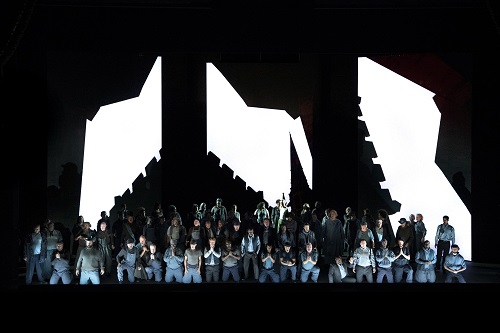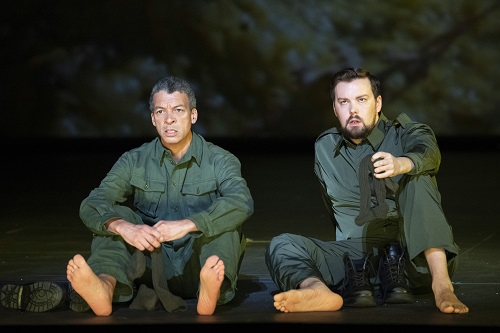 United Kingdom Britten: Emma Bell (soprano), David Butt Philip (tenor), Roderick Williams (baritone), Finchley Children’s Music Group, ENO War Requiem Ensemble (Porgy and Bess Ensemble and Chorus of English National Opera), Orchestra of English National Opera / Martyn Brabbins (conductor). London Coliseum, 16.11.2018. (CC)
United Kingdom Britten: Emma Bell (soprano), David Butt Philip (tenor), Roderick Williams (baritone), Finchley Children’s Music Group, ENO War Requiem Ensemble (Porgy and Bess Ensemble and Chorus of English National Opera), Orchestra of English National Opera / Martyn Brabbins (conductor). London Coliseum, 16.11.2018. (CC)

Britten – War Requiem, Op.66
Production:
Director – Daniel Kramer
Designer – Wolfgang-Tillmas
Costume designer – Nasir Mazhar
Associate designer – Justin Nardella
Lighting designer – Charles-Balfour
Choreographer – Ann-Yee
A busy couple of days for Martyn Brabbins, who conducted Ethel Smyth’s Mass in D and Tchaikovsky’s First Piano Concerto at the Barbican the previous evening, standing in for Sakari Oramo (for review click here). There was no lack of energy from the playing in this War Requiem, though: the orchestra was focused and committed, and Brabbins is no stranger to the score, having recorded it for Naxos (with the BBC Scottish SO). Both full orchestra and chamber orchestra were located in the pit, with percussion spilling out over to the sides (the latter provided some improvised sections between scenes; these ‘breaks’ accounted for the slightly longer playing time of the evening).
The idea to stage the War Requiem (this the first in the UK) is fully congruent with ENO’s commitment to staging sacred music and oratorio: there has been a Messiah from Deborah Warner in 2009, a St John Passion in 2000 and Peter Sellars’s The Gospel According to the Other Mary in 2014. Here, Daniel Kramer directs, with Wolfgang Tilmans as Designer, Charles Balfour as Lighting Designer and Ann Yee as Choreographer. East London-based costume designer Nasir Mazhar provides convincing period dress.
ENO’s excellence with technology, demonstrated on multiple occasions, is once more on display here. Massive screens display anti-war propaganda, an appeal from Srebrenica (fleshed out by an essay, ‘Kada Hotić – Seamstress of Srebrenica’ in the exceptionally lavish programme booklet) alongside scenes of the utmost violence mirrored by the blind violence of today’s football hooligans. Nature also plays a huge part in the visual display, as do Tilmans’s photos of Coventry Cathedral (for whose re-consecration the War Requiem was written; as was, of course, Bliss’s Beatitudes). Tilmans’s photos are all visually stunning, to the extent there is almost a sensory overload going on: in 2000, Tilmans was the first photographer to win the Turner Prize. The images of Nature decaying as the wheel of the year turns are powerful indeed: a meditation on the transitory nature of life per se and its cruel foregrounding in times of conflict. Nature eventually invades the stage in the form of the enshrouding balm of snowfall. Layering all this on to Britten’s score is brave indeed; meanwhile, the soloists act out scenes of war camaraderie and violence, the combined chorus mobile in a way the composer surely never intended. And yet, it works in the sense that the emotional pull is irresistible, while the impression of a series of disconnected scenes as opposed to through-composed narrative reflects the cathedral-based origins of the piece. There is a sad inevitability perhaps, that Roderick Williams’s knife-wielding carried uncomfortable resonance with today’s proliferation of knife crime. The wheel continues to turn, and not just purely in Nature’s seasons, a facet mirrored in the appearance of young people in modern dress towards the end of the piece.

The immersion of all three soloists in their parts was undeniable. Vocally, it was impossible to light on one particular voice that shone. Tenor David Butt Philip, most associated with Puccini at ENO (Rodolfo and Pinkerton), was supremely eloquent in Wilfred Owens’s ‘What passing bells for these who die as cattle?’ in the opening ‘Requiem aeternam’, and issued forth the most beautiful sound in the final ‘Libera me’. Emma Bell had all the strength required, her ‘Lacrymosa’ in the ‘Dies irae’ searing, while her presence in the ‘Libera me’ was unforgettable, palpably emotional yet negotiating Britten’s angular line with ease. Roderick Williams, who seems to turn everything he touches into gold, was magnificent; more, the many passages wherein Britten pairs tenor and bass found the two characters working beautifully together, both vocally and dramatically. The sparring between war colleagues was brilliantly done, while the tale of Abraham (‘Abram’) in the ‘Offertorium’ was heart-rending theatre.
The supplemented chorus was deployed in a multiplicity of formations, be it military formation or mourners (the funeral of an unknown soldier) or circling like prisoners. Whatever they were asked to do, they embraced completely, the sheer wall of sound at times overwhelming: the ‘Confutatis maledictis’ was supremely exciting. The orchestra throughout were superb, as they were in the recent Lucia (for review click here). The brass fanfares at the opening of the ‘Dies irae’ were brilliantly, and poignantly, managed, that acerbic harmonic twang so characteristic of Britten’s world resonating fully. Very occasionally there was a slight scrappiness in the strings, but there is no doubting the high standard elicited by Brabbins, whose grasp of the work’s structure was never in doubt.
Nice to have surtitles in both Latin and English, where applicable. A powerful evening. ENO continues to push the boundaries. For some, Britten’s War Requiem is holy ground and should not be tampered with; yet Daniel Kramer’s vision, in tandem with Tilmans’s unforgettable photography, questions that effectively.
Colin Clarke
For more about ENO click here.